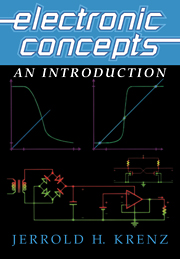Book contents
- Frontmatter
- Contents
- Preface
- 1 ELECTRONIC SYSTEMS: A CENTURY OF PROGRESS
- 2 THE SEMICONDUCTOR JUNCTION DIODE: THE BASIS OF MODERN ELECTRONICS
- 3 THE BIPOLAR JUNCTION TRANSISTOR: AN ACTIVE ELECTRONIC DEVICE
- 4 THE METAL-OXIDE FIELD-EFFECT TRANSISTOR: ANOTHER ACTIVE DEVICE
- 5 NEGATIVE FEEDBACK AND OPERATIONAL AMPLIFIERS
- 6 ELECTRONIC POWER SUPPLIES
- APPENDIX A FABRICATION OF INTEGRATED CIRCUITS
- APPENDIX B THE DESIGN PROCESS
- Index
6 - ELECTRONIC POWER SUPPLIES
Published online by Cambridge University Press: 05 June 2012
- Frontmatter
- Contents
- Preface
- 1 ELECTRONIC SYSTEMS: A CENTURY OF PROGRESS
- 2 THE SEMICONDUCTOR JUNCTION DIODE: THE BASIS OF MODERN ELECTRONICS
- 3 THE BIPOLAR JUNCTION TRANSISTOR: AN ACTIVE ELECTRONIC DEVICE
- 4 THE METAL-OXIDE FIELD-EFFECT TRANSISTOR: ANOTHER ACTIVE DEVICE
- 5 NEGATIVE FEEDBACK AND OPERATIONAL AMPLIFIERS
- 6 ELECTRONIC POWER SUPPLIES
- APPENDIX A FABRICATION OF INTEGRATED CIRCUITS
- APPENDIX B THE DESIGN PROCESS
- Index
Summary
Essentially all electronic systems require a nonvarying supply voltage (or current), that is, a dc voltage (or dc current). On the other hand, the electric power supplied by utilities is characterized by an alternating voltage and current having a sinusoidal time dependence. In North America, a frequency of 60 Hz is common, whereas 50 Hz is used in most other areas of the world. Utility potentials depend on the usage: residential service is 120 V (rms) in North America, whereas 220–240 V is common for residential service elsewhere.
A semiconductor junction diode allows a current in only one direction; its reverse-biased current is negligibly small and can be ignored for nearly all applications. Hence, a diode may be used to convert an alternating source of current to a current with a single direction – a process generally referred to as rectification. For many electronic applications it is also necessary to transform the utility voltage to a desired voltage using an iron-core transformer.
The resistor RL of the power supply of Figure 6.1 represents the load to which electrical power is to be supplied. The secondary voltage of the transformer vTrans(t) is rectified by the diode, resulting in a load voltage vLoad(t) that has a single polarity. The load current vLoad(t)/RL also has a single polarity.
The usefulness of the supply shown in Figure 6.1 is very limited because the load voltage is zero for a significant portion of each period of the input voltage.
- Type
- Chapter
- Information
- Electronic ConceptsAn Introduction, pp. 369 - 422Publisher: Cambridge University PressPrint publication year: 2000



